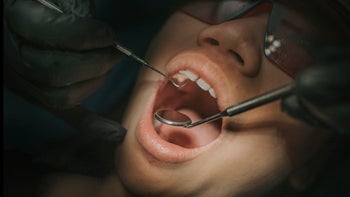
How Much Does Liposuction Cost?
Key takeaways:
Liposuction is a surgical procedure that removes fat beneath your skin.
The cost of liposuction ranges from $1,000 to $20,000 for one treatment area, with an average cost of $3,600 per treatment area.
Liposuction is not typically covered by most insurance plans.

Liposuction is a cosmetic surgical procedure that removes fat from the body. As the name suggests, this procedure breaks up and sucks out fat. Liposuction is not a weight-loss solution and doesn’t firm or tighten skin.
The average liposuction treatment costs about $3,600, according to 2020 figures from the American Society of Plastic Surgeons. Costs can range from $1,000 to more than $20,000, according to the American Board of Cosmetic Surgery’s cosmetic surgery pricing tool. Prices depend on the part of the body, where you live, the surgeon’s skill, and associated fees.
Typically, liposuction is not covered by insurance.
Search and compare options
What is liposuction?
Liposuction is a cosmetic procedure that breaks up and removes fat from a section of your body. The surgeon pierces your skin to insert a small tube called a cannula. Fat gets suctioned out of your body through the cannula to sculpt the area. Then the incision gets closed, which may leave a small scar.
Only licensed surgeons can perform liposuction, which is also known as body sculpting, body contouring, or lipoplasty.
What parts of the body can have liposuction?
Liposuction is available for many parts of the body, including:
Abdomen (upper and lower)
Arms
Back
Buttocks
Chest
Hips
Neck
Thighs (inner and outer)
Your surgeon will examine you and discuss the options that are right for you.
How much does liposuction typically cost?
Liposuction costs vary depending on a number of factors, including:
Area of the body treated
Number of areas treated
Cost of surgeon
Difficulty of procedure
Fees for the facility, anesthesiologist, and supplies
Read more like this
Explore these related articles, suggested for readers like you.
According to 2020 data from the American Society of Plastic Surgeons, the average cost of liposuction is $3,637 per area of the body. This estimate does not include the cost of anesthesia, facility fees, or other expenses.
The American Board of Cosmetic Surgery offers a cost calculator that provides a price range for a selected procedure based on your ZIP code.
Insurance does not usually cover liposuction. However, liposuction for people who have had bariatric surgery may be covered alone or with skin-removal procedures. Coverage also may be provided, if deemed medically necessary, depending on the insurance company and your plan. For instance, Aetna covers liposuction for some people seeking breast reconstruction or gender-affirming surgery.
The Houston Lipo Center in Texas offers all-inclusive packages for single areas. For $3,900 to $4,900, a single area includes:
Arms
Abdomen (upper or lower)
Back (upper or mid)
Buttocks
Calves
Thighs (outer or inner)
Waist/hips (female)
Love handles/flanks (male)
Many clinics will offer prices upfront for the procedure only. Unless you have an all-inclusive price, most liposuction treatments involve additional fees.
What are the additional costs of liposuction?
Some surgeons have all-inclusive packages for liposuction. Others charge for the procedure, then add additional fees as needed.
Possible additional costs for liposuction include:
Consultation fees
Medical tests
Surgical facility costs
Anesthesia fees
Surgeon’s fees
Antibiotics or other medications
Compression garments and wound-care dressings
Is liposuction worth it?
Depending on your goals and your outcome, liposuction may be well worth it for you. If you have had bariatric surgery or lost a lot of weight by another method, liposuction on its own or — with skin-removal surgery — can be deemed medically necessary.
Liposuction is a spot treatment for areas of excess fat and is not a weight-loss tool.
Here are some advantages of liposuction:
Visible improvement (full results once swelling subsidies)
Targeted sculpting of a specific area
Minimal scarring and recovery time
Most procedures are outpatient
In some cases, liposuction is not an ideal solution. The procedure breaks up and sucks out fat under your skin but will not:
Get rid of stretch marks or cellulite
Help you lose weight or replace bariatric surgery
Remove deep abdominal fat
Prevent your body from creating more fat in the same area
Does insurance cover liposuction?
Not usually. Insurance does not typically cover liposuction unless it is considered medically necessary. The definition of what is medically necessary varies by insurance provider and health plan. Some liposuction is approved for people seeking:
Breast reconstruction
Gender-affirming surgery
Skin removal after massive weight loss
Contact your insurance company to verify whether your liposuction can be covered. Often, coverage for a cosmetic procedure requires prior authorization.
How long does liposuction last?
Liposuction permanently removes fat, but it doesn’t prevent your body from generating new fat. How long your results last depends entirely on maintaining your current size, which often involves your weight and fitness level.
What are the risks of liposuction?
As with all medical procedures, liposuction has risks. They include:
Swelling
Numbness
Fluid retention
Bruising
Skin abnormalities
Internal puncture
Infections
What are the challenges involved in recovering from liposuction?
Typically, you will need about 6 weeks to recover from liposuction. Your surgeon may prescribe pain medications or suggest over-the-counter pain relievers. You will need to keep the surgical site clean, and you may need to wear a compression garment.
You may not see immediate results because of swelling. Over time, you will see the outcome of the procedure.
You may not be satisfied with your results. The reasons could include:
Your skin may be bumpy.
You may not have achieved the contouring you desired.
You may have experienced complications from the procedure, such as a puncture or an infection.
You may experience a fat embolism resulting from liposuction that causes tiny pieces of fat to float into your bloodstream, possibly causing blockages that could become deadly.
Are there alternatives I should consider?
Cosmetic procedures involve risks. You might consider noninvasive alternatives to liposuction, such as:
Diet and exercise
CoolSculpting — also known as cryolipolysis — which freezes your fat cells
Kybella, a localized, fat-melting injection used to reduce a double chin
SculpSure, Zerona, and other treatments that use laser or ultrasound technology
TruSculpt and other treatments that melt fat using heat created by radio frequencies
Sometimes these methods can be combined to achieve better results.
The bottom line
Liposuction removes fat from a section of the body. The cosmetic procedure involves at least one incision, suction, stitching, and anesthesia. Costs for one area of the body range from $1,000 to $20,000, depending on where you live, the part of the body, the surgeon’s skill, and associated fees.
Most insurance plans don’t cover liposuction. There are exceptions when liposuction is considered medically necessary, such as after weight-loss surgery, for breast reconstruction, for gender-affirming surgery, and to assist with lipedema.
Why trust our experts?


References
Aetna. (2022). Cosmetic surgery and procedures.
Adeyinka, A., & Pierre, L. (2022). Fat embolism. StatPearls.
American Academy of Cosmetic Surgery. (n.d.). Liposuction.
American Board of Cosmetic Surgery. (2018). Cosmetic surgery pricing.
American Board of Cosmetic Surgery. (2021). How to choose between liposuction and noninvasive fat reduction procedures.
American Society of Plastic Surgeons. (n.d.). What is liposuction?
American Society of Plastic Surgeons. (n.d.). How much does liposuction cost?
Austin Body Contouring. (n.d.). Zerona vs SculpSure.
Houston Lipo Center. (n.d.). Liposuction cost.
Jalian, H.R., et al. (2022). Submental fat reduction using sequential treatment approach with cryolipolysis and ATX-101. Journal of Cosmetic Dermatology.
Johns Hopkins Medicine. (n.d.). Liposuction.
Lipedema Foundation. (n.d.). What is lipedema?
MyKybella.com. (n.d). About Kybella.
Ngage, L.M., et al. (2020). Review of insurance coverage for abdominal contouring procedures in the postbariatric population. Plastic and Reconstructive Surgery.
TruSculpt. (n.d.). TruSculpt by Cutera.




























